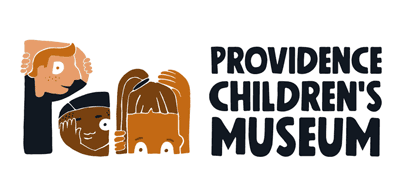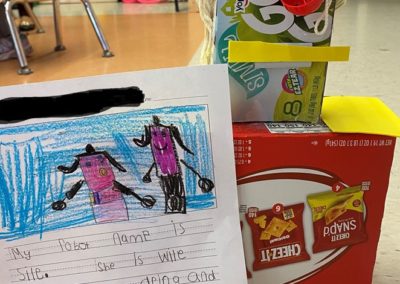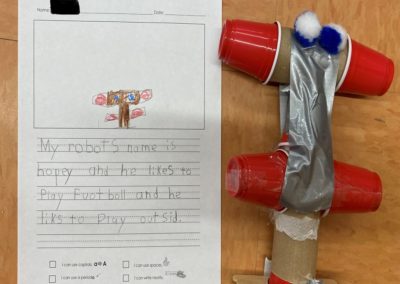Bot Creation
Developed by Katherine Smith, PCM Play Intensive 2021
(FOCUS:K-2, STEAM, Language & Literacy Approach: Creativity & Making, Engineering and Design Process Length: Part 1 & Part 2)
This lesson is based on the story “Dylan and The Magical Robot”. Dylan Is creative boy who loves to draw. One day, he draws the most magnificent robot that comes to life! The student’s eyes light up throughout the whole story and they are even more excited when they realize that they get the chance to draw and bring to life their very own robot! This is a great lesson for students to be able to participate in a hands-on engineering activity while being able to connect in common core writing standards.
Part 1: After students listen to the read out loud, they will be able to choose from different materials to create their own robot.
Part 2: The next day students will work on writing an informative writing piece providing more information about their robot (name, description, job)
Materials
- “Dylan and The Magical Robot” by Sol Regwan
- Copies of Writing paper (depending on grade level)
- Pencils
- Scissors
- Paper Towel/Toilet Paper Rolls
- Any Home Recycled Goods (We sent out a letter to parents asking for recycled good donations). The Items we received consisted of:
- Construction Paper
- Tape/Glue
- Plastic Cups
- Cardboard
- Egg Cartons
- Googly Eyes
- Q-Tips
- Buttons
- Pipe cleaners
- Milk jugs
Set Up
Have all the materials spread out on table so students can come choose what they would like to work with.
Have copies ready of writing paper
Student’s Job
Create a robot with recycled goods and write an informative piece based on their creation in hopes to sell their new robot toy to Hasbro.
Prompt:
You have two challenges today. Your first challenge is to draw a magnificent robot. Your second challenge is to bring it to life! You get to use the recycled materials on the back table to transform your drawing into a real robot.
- Draw a robot
- Use the recycled materials to bring your robot to life by making a 3D version of your drawing.
- Write an Informative writing piece OR a persuasive writing piece about your robots In hopes to persuade Hasbro toys to buy your robot from you.
Further Challenges:
After the students are done completing their robot, the students will complete a writing prompt to help bring their robot to life. The writing prompt should include the robot’s name and his favorite jobs to do.
Teacher’s Job
Standards Alignment:
COMMON CORE STATE STANDARDS.ELA-LITERACY.LANGUAGE.K.1
Demonstrate command of the conventions of standard English grammar and usage when writing or speaking.
COMMON CORE STATE STANDARDS.ELA-LITERACY.LANGUAGE.K.2
Demonstrate command of the conventions of standard English capitalization, punctuation, and spelling when writing.
COMMON CORE STATE STANDARDS.ELA-LITERACY.WRITING.K.2
Use a combination of drawing, dictating, and writing to compose informative/explanatory texts in which they name what they are writing about and supply some information about the topic.
COMMON CORE STATE STANDARDS.ELA-LITERACY.WRITING.K.5
With guidance and support from adults, respond to questions and suggestions from peers and add details to strengthen writing as needed.
NEXT GENERATION SCIENCE STANDARDS: ENGINEERING DESIGN
K-2-ETS1-1. Ask questions, make observations, and gather information about a situation people want to change to define a simple problem that can be solved through the development of a new or improved object or tool.
K-2-ETS1-2. Develop a simple sketch, drawing, or physical model to illustrate how the shape of an object helps it function as needed to solve a given problem.
Connections to previous work?
Focus on different types of STEAM projects such as:
- Building the Three Little Pig houses and seeing if they can withstand the Big Bad Wolf also known as the Blow-dryer
- Creating their own mayflower to see if it can float or sink with passengers on board (teddy bears)
- Designing and creating their own solar system planet.
Prepare/ Background Info
Before this lesson the students will listen to the story “The Most Magnificent Thing” to help them learn about the trial-and-error process of creating. We will go over the word “grit’ and use it in our language as the lesson unfolds.
1. Read the story “Dylan and The Magical Robot”
2. Facilitate and encourage students in the designing process
3. Go over writing expectations and provide feedback
Extend/ Take it Further
The students will all have time to share their robots and writing after they are complete. I am hoping to be able to put them on display somewhere in the school so other classes can admire their hard work!
To extend this lesson the students could also participate in some coding activities to go along with the robot building.
Facilitation Strategies
Before starting, the teacher should go over the rules and expectations of what is to be expected during the building portion of the lesson (ex. voice volume, appropriate use of materials, etc.)
The teacher should walk around while providing feedback through compliments and questions.
The teacher should provide the students with ample time to complete their projects. If the students finish early, they should take out a book to read. The teacher should also provide reminders when the time to finish is getting close.
During the writing portion of the lesson, the teacher will go over a writer’s checklist to help the students understand the expectations of the writing.
When the students have finished their writing, they will get it checked by the teacher and correct any revisions or errors.
Play to Notice (Learning Framework)
Choice, emotional, social, active
Content Matter to Notice
Literacy, STEAM, writing
SEL to Notice
It Is important to notice which students are getting frustrated or anxious about the creative process of this lesson. Use positive reinforcement and use (I wonder) questions to help them get on track. It Is also Important to notice the students who are taking a leadership role and providing help to others who seem to be struggling.




0 Comments